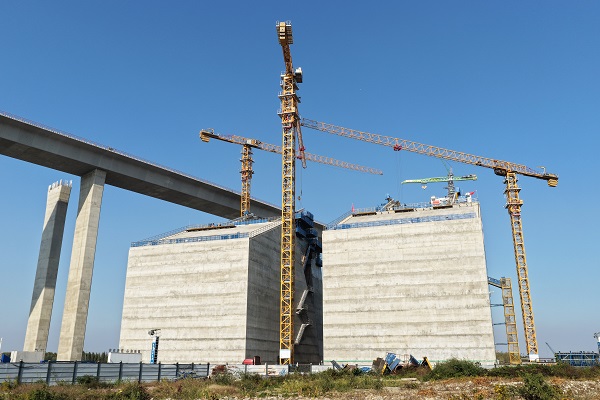
Anchors are the "anchoring needles" of large bridges, playing a core role in ensuring the overall structural stability of the bridge. The south anchorage of the North Channel Bridge adopts a "suspended diaphragm wall+full section deep foundation reinforcement composite anchorage foundation" scheme, and is equipped with a double anchor block design. The project scale is large and the technical content is high. The total weight of the anchorage is as high as 500000 tons, equivalent to the total weight of 500000 family cars; Accumulated pouring of 220000 cubic meters of concrete, with a volume equivalent to approximately 110 standard swimming pools. The first phase of the project covers the construction of anchor foundations, anchor bodies, anchor systems, and some ancillary facilities. After the lifting of the upper structure steel box girder is completed, the project will enter the second phase, focusing on the construction of the front anchor room roof, front wall, and the completion of the remaining ancillary works.
The construction of the south anchorage of the North Channel Bridge faces three major technical challenges: firstly, the control standards for the verticality (≤ 1/800) and wall accuracy (≤ 30 millimeters) of the ultra deep connecting wall are extremely high, and its quality directly affects the safety of the entire large foundation pit. Secondly, in the deep and rich water soft soil layer, the first application of full section deep foundation reinforcement and horizontal bottom sealing technology lacks mature experience reference, and the construction difficulty and risk are prominent. Thirdly, the anchor concrete has a large volume and strict requirements for controlling hydration heat, which requires effective prevention and control of temperature cracks. In response to the world-class problem of crack prevention in large volume concrete, the project team optimized the mix design and adopted a scheme of "low cementitious materials, low cement dosage, reasonable water cement ratio, and increased efficiency of functional materials" to achieve dual control of hydration rate and expansion process, reducing the peak value of hydration heat by more than 20%. The combination of intelligent temperature control system for real-time dynamic monitoring of temperature difference inside and outside concrete effectively suppresses the occurrence of temperature cracks, significantly improves the durability of anchor concrete, and provides strong guarantee for building a century old quality project.
Important Node Review
The south anchorage of the north channel bridge of Zhang Jinggao Yangtze River Bridge is located on Minzhu Sand Island in the Yangtze River. This island is formed by long-term sedimentation of the Yangtze River sediment, with no rock layers more than 100 meters underground. The soil has a high moisture content and is soft like "tofu chunks". In order to firmly root the anchor body weighing 500000 tons on the "tofu block", the project team carried out ultra-high pressure rotary spraying reinforcement on the soft clay with a thickness of 28 meters below the foundation, with a maximum reinforcement depth of over 50 meters. In the early stage, a multi-stage process test research was carried out for 8.5 months, and a D-RJP A new construction technology has been developed, with more than 20 key process parameters determined. An intelligent control system for construction has been developed, and through intelligent control and refined management, engineering technical problems such as the verticality of deep foundation reinforcement holes, the diameter and strength of clay layer piles, and the interlocking effect between piles have been overcome. 2497 ultra-high pressure rotary jet grouting piles have been successfully inserted into the "tofu block", overcoming the problem of large-scale deep foundation reinforcement. This innovative measure of "artificial large-scale high-performance improvement of foundations" has opened up new ideas and accumulated new experience for the construction of anchorages in deep and rich water soft soil geology.
Correspondent: Stanford
